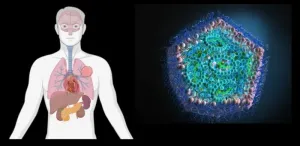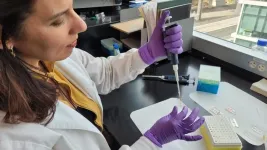(Press-News.org) Implementing bans on the advertising, promotion, and sponsorship of tobacco products is linked to 20% lower odds of smoking, and 37% lower risk of taking up the habit, reveals a pooled data analysis of the available research, published online in Tobacco Control.
The findings indicate that these bans do influence behaviour, lending further weight to calls for their wider international implementation and enforcement, conclude the researchers.
In 2019 alone, more than a billion people around the globe regularly smoked tobacco, and smoking caused nearly 8 million deaths, note the researchers.
To curb the toll taken by smoking, the World Health Organization set out guidance for countries on how to adopt comprehensive tobacco control policies in its Framework Convention on Tobacco Control (FCTC), explain the researchers.
Yet only 17 of the 182 parties involved have implemented comprehensive bans of all the listed types of tobacco advertising, promotion, and sponsorship, while 37 haven’t implemented any bans at all, they add.
To update and strengthen the evidence base, amid a rapidly evolving media and advertising landscape, the researchers explored the impact of comprehensive tobacco product advertising, promotional, and sponsorship bans on smoking prevalence, uptake, and cessation, drawing on the most recently published research up to April 2024.
After excluding studies that were duplicates, poorly designed, or ineligible, they included 16, all of which were published in English, and involved around half a million participants, in their pooled data analysis.
Two studies analysed the impact of bans on current smoking over a period of less than 5 years, 5 over a period of 5–10 years, and 3 over a period of more than 10 years.
Smoking uptake was evaluated for fewer than 5 years in 2 studies, and for more than 10 years in another 2. All 3 studies looking at smoking cessation evaluated the impact of bans over 5–10 years.
Pooled data analysis of all the study results showed that bans were associated with a 20% lower prevalence of smoking and a 37% lower risk of smoking uptake.
But there was no association between the bans and smoking cessation, possibly because of the small number of studies assessing this and the relatively high attrition rates noted in those studies, suggest the researchers.
Further detailed analysis revealed that the associations found between the bans and smoking prevalence differed by duration of the evaluation period. For example, the reduction in this was greater in studies evaluating the policy over 5 to 10 years than in those evaluating shorter periods.
Twelve (81%) of the included studies had a moderate risk of bias, while 3 (19%) had a high risk, and most of the studies assessed only partial bans, acknowledge the researchers.
Most of the included studies were also of observational design with no direct comparators, so limiting their ability to make causal inferences.
“Tobacco advertising and promotion increase awareness and receptivity towards cigarettes and provoke positive attitudes towards tobacco smoking. Youth and young adult populations are particularly susceptible to the negative influences of tobacco advertisement as exposure to tobacco marketing more than doubles their chances of smoking initiation,” explain the researchers.
“Our results suggest that [advertising, promotional, and sponsorship bans] can be effective in reducing smoking prevalence and the risk of smoking uptake…..Given the findings of this review, it is likely that comprehensive bans would have greater impacts on smoking behaviour,” they write.
And they conclude: “The findings reinforce the need for countries to implement and enforce existing [tobacco advertising, promotional, and sponsorship] bans to reduce tobacco smoking and its consequences.”
END
Tobacco advertising + sponsorship bans linked to 20% lower odds of smoking
And 37% lower risk of smoking uptake, indicating these bans’ influence on behaviour. More countries should adopt these policies to save lives, urge researchers
2025-01-14
ELSE PRESS RELEASES FROM THIS DATE:
Vascular ‘fingerprint’ at the back of the eye can accurately predict stroke risk
2025-01-14
A vascular ‘fingerprint’ on the light sensitive tissue layer at the back of the eye—the retina—can predict a person’s risk of stroke as accurately as traditional risk factors alone, but without the need for multiple invasive lab tests, finds research published online in the journal Heart.
The fingerprint, comprising 29 indicators of vascular health, is a practical and readily implementable approach that is particularly well suited for primary healthcare and low-resource settings, conclude the researchers.
Stroke affects around 100 million people around the globe and ...
Circulation problems in the brain’s seat of memory linked to mild cognitive impairment in older adults
2025-01-14
Mild cognitive impairment is linked to blood vessel dysfunction in the brain’s temporal lobes — the seat of memory — according to a new USC-led study.
The findings, seen in people with and without signs of amyloid buildup in the brain, suggest that microvascular trouble may be an important, early biomarker for dementia as well as a potential target for therapy.
The research, involving scientists from multiple universities, appears in the journal Neurology.
“We’re studying ...
Oregon State receives $11.9 million from Defense Department to enhance health of armed forces
2025-01-13
PORTLAND, Ore. – The U.S. Department of Defense has awarded up to $11.9 million to Oregon State University to invent new drug delivery technologies for protecting members of the military from a range of health threats in combat areas.
Once designed, developed and tested, the technologies could also be applied as needed within the general public, said OSU College of Pharmacy nanomedicine researcher Gaurav Sahay, the project leader.
The award comes from the Defense Advanced Research Projects Agency through its Hermes program, whose goal is finding new ways to deliver therapeutic agents throughout the body with exceptional ...
Leading cancer clinician, researcher Dr. Jenny Chang to lead Houston Methodist Academic Institute
2025-01-13
Esteemed cancer clinician-scientist Jenny Chang, M.D., MBBChir, MHCM, has been chosen to lead the Houston Methodist Academic Institute. She will serve as executive vice president, president and CEO, and chief academic officer.
In her more than 15 years at Houston Methodist, Chang helped transform the Dr. Mary and Ron Neal Cancer Center into one of the top-20 ranked cancer centers in the country.
Chang, the Emily Herrmann Presidential Distinguished Chair in Cancer Research, was selected following a national search and succeeds H. Dirk Sostman, M.D., FACR, who will retire next month after two decades of leadership at Houston Methodist.
Chang’s ...
Engineering quantum entanglement at the nanoscale
2025-01-13
Physicists have spent more than a century measuring and making sense of the strange ways that photons, electrons, and other subatomic particles interact at extremely small scales. Engineers have spent decades figuring out how to take advantage of these phenomena to create new technologies.
In one such phenomenon, called quantum entanglement, pairs of photons become interconnected in such a way that the state of one photon instantly changes to match the state of its paired photon, no matter how far apart they are.
Nearly 80 years ago, Albert Einstein referred to this phenomenon as "spooky action at a distance." Today, entanglement is the subject of research ...
Researchers develop breakthrough one-step flame retardant for cotton textiles
2025-01-13
Although extremely flammable, cotton is one of the most commonly used textiles due to its comfort and breathable nature. However, in a single step, researchers from Texas A&M University can reduce the flammability of cotton using a polyelectrolyte complex coating. The coating can be tailored for various textiles, such as clothing or upholstery, and scaled using the common pad-dry coating process, which is suitable for industrial applications. This technology can help to save property and lives on a large scale.
“Many of the materials in our ...
New study identifies how blood vessel dysfunction can worsen chronic disease
2025-01-13
Researchers at Oregon Health & Science University have uncovered how specialized cells surrounding small blood vessels, known as perivascular cells, contribute to blood vessel dysfunction in chronic diseases such as cancer, diabetes and fibrosis. The findings, published today in Science Advances, could change how these diseases are treated.
The study, led by Luiz Bertassoni, D.D.S., Ph.D., founding director of the Knight Cancer Precision Biofabrication Hub and a professor at the OHSU Knight Cancer Institute and ...
Picking the right doctor? AI could help
2025-01-13
Years ago, as she sat in waiting rooms, Maytal Saar-Tsechansky began to wonder how people chose a good doctor when they had no way of knowing a doctor’s track record on accurate diagnoses. Talking to other patients, she found they sometimes based choices on a physician’s personality or even the quality of their office furniture.
“I realized all these signals people are using are just not the right ones,” says Saar-Tsechansky, professor of information, risk, and operations management at Texas McCombs. “We were operating in complete darkness, like there’s no transparency on these things.”
In new research, she uses artificial ...
Travel distance to nearest lung cancer facility differs by racial and ethnic makeup of communities
2025-01-13
Embargoed for release until 5:00 p.m. ET on Monday 13 January 2025
@Annalsofim
Below please find summaries of new articles that will be published in the next issue of Annals of Internal Medicine. The summaries are not intended to substitute for the full articles as a source of information. This information is under strict embargo and by taking it into possession, media representatives are committing to the terms of the embargo not only on their own behalf, but also on behalf ...
UTA’s student success strategy earns national acclaim
2025-01-13
The University of Texas at Arlington has been recognized nationally for its commitment to student success and economic mobility, being named a winner in the inaugural Postsecondary Success Recognition Program (PSRP), a U.S. Department of Education initiative. This program honors institutions that excel in enrolling underserved student populations, supporting successful student transfers and completions and preparing graduates for careers that promote economic mobility.
UTA was one of only three bachelor’s degree–granting institutions across the nation ...
LAST 30 PRESS RELEASES:
Superradiant spins show teamwork at the quantum scale
Cleveland Clinic Research links tumor bacteria to immunotherapy resistance in head and neck cancer
First Editorial of 2026: Resisting AI slop
Joint ground- and space-based observations reveal Saturn-mass rogue planet
Inheritable genetic variant offers protection against blood cancer risk and progression
Pigs settled Pacific islands alongside early human voyagers
A Coral reef’s daily pulse reshapes microbes in surrounding waters
EAST Tokamak experiments exceed plasma density limit, offering new approach to fusion ignition
Groundbreaking discovery reveals Africa’s oldest cremation pyre and complex ritual practices
First breathing ‘lung-on-chip’ developed using genetically identical cells
How people moved pigs across the Pacific
Interaction of climate change and human activity and its impact on plant diversity in Qinghai-Tibet plateau
From addressing uncertainty to national strategy: an interpretation of Professor Lim Siong Guan’s views
Clinical trials on AI language model use in digestive healthcare
Scientists improve robotic visual–inertial trajectory localization accuracy using cross-modal interaction and selection techniques
Correlation between cancer cachexia and immune-related adverse events in HCC
Human adipose tissue: a new source for functional organoids
Metro lines double as freight highways during off-peak hours, Beijing study shows
Biomedical functions and applications of nanomaterials in tumor diagnosis and treatment: perspectives from ophthalmic oncology
3D imaging unveils how passivation improves perovskite solar cell performance
Enriching framework Al sites in 8-membered rings of Cu-SSZ-39 zeolite to enhance low-temperature ammonia selective catalytic reduction performance
AI-powered RNA drug development: a new frontier in therapeutics
Decoupling the HOR enhancement on PtRu: Dynamically matching interfacial water to reaction coordinates
Sulfur isn’t poisonous when it synergistically acts with phosphine in olefins hydroformylation
URI researchers uncover molecular mechanisms behind speciation in corals
Chitin based carbon aerogel offers a cleaner way to store thermal energy
Tracing hidden sources of nitrate pollution in rapidly changing rural urban landscapes
Viruses on plastic pollution may quietly accelerate the spread of antibiotic resistance
Three UH Rainbow Babies & Children’s faculty elected to prestigious American Pediatric Society
Tunnel resilience models unveiled to aid post-earthquake recovery
[Press-News.org] Tobacco advertising + sponsorship bans linked to 20% lower odds of smokingAnd 37% lower risk of smoking uptake, indicating these bans’ influence on behaviour. More countries should adopt these policies to save lives, urge researchers




